Cracking the SAT with 5 Practice Tests, 2014 Edition (2013)
Part VII. The Princeton Review SAT Practice Tests and Explanations
Chapter 23. Practice Test 3
(Click here to download a PDF of Practice Test 3)
![]()
SECTION 1
ESSAY
Time — 25 minutes
Turn to Section 1 of your answer sheet to write your essay.
The essay gives you an opportunity to show how effectively you can develop and express ideas. You should, therefore, take care to develop your point of view, present your ideas logically and clearly, and use language precisely.
Your essay must be written on the lines provided on your answer sheet—you will receive no other paper on which to write. You will have enough space if you write on every line, avoid wide margins, and keep your handwriting to a reasonable size. Remember that people who are not familiar with your handwriting will read what you write. Try to write or print so that what you are writing is legible to those readers.
You have twenty-five minutes to write an essay on the topic assigned below. DO NOT WRITE ON ANOTHER TOPIC. AN OFF-TOPIC ESSAY WILL RECEIVE A SCORE OF ZERO.
Think carefully about the issue presented in the following excerpt and the assignment below.
Whenever any form of government becomes destructive to these ends [the natural rights of men], it is the right of the people to alter or to abolish it, and to institute new government, laying its foundation on such principles and organizing its powers in such form, as to them shall seem most likely to effect their Safety and Happiness.
The Declaration of Independence
Assignment: Does questioning authority make a society stronger? Plan and write an essay in which you develop your point of view on this issue. Support your position with reasoning and examples taken from your reading, studies, experience, or observations.
DO NOT WRITE YOUR ESSAY IN YOUR TEST BOOK. You will receive credit only for what you write on your answer sheet.
BEGIN WRITING YOUR ESSAY ON THIS PAGE OF THE ANSWER SHEET
(FOUND AT THE BACK OF THE BOOK).
S T O P
If you finish before time is called, you may check your work on this section only.
Do not turn to any other section in the test.
![]()
SECTION 2
Time — 25 minutes
20 Questions
Turn to Section 2 of your answer sheet to answer the questions in this section.
Directions: For this section, solve each problem and decide which is the best of the choices given. Fill in the corresponding circle on the answer sheet. You may use any available space for scratchwork.


1. If 4y + 8 = 12y + 24, then y =
(A) –2
(B) –1
(C) 1
(D) 2
(E) 4
2. If f(2) = 10 and f(4) = 44, which of the following could be f(x) ?
(A) 2x + 6
(B) 2x2 + 12
(C) 2x3 + 2
(D) 2x3 – 4x
(E) 3x2 – x
3. A jar contains a number of jelly beans of which 58 are red, 78 are green, and the rest are blue. If the probability of choosing a blue jelly bean from this jar at random is ![]() , how many blue jelly beans are in the jar?
, how many blue jelly beans are in the jar?
(A) 34
(B) 56
(C) 78
(D) 102
(E) 152
4. If the nth term in a sequence is 3 × 2n, what is the 10th term in the sequence?
(A) 60
(B) 1,024
(C) 1,536
(D) 3,072
(E) 6,144
5. If 3 more than x is 2 more than y, what is x in terms of y?
(A) y – 5
(B) y – 1
(C) y + 1
(D) y + 5
(E) y + 6
6. ABCD is a quadrilateral such that AB = BC, AD = ![]() CD and AD =
CD and AD = ![]() AB. If BC = 12, what is the perimeter of ABCD?
AB. If BC = 12, what is the perimeter of ABCD?
(A) 44
(B) 42
(C) 40
(D) 36
(E) 33
7. If a, b, c, and d are consecutive multiples of 5, and a < b < c < d, what is the value of (a – c)(d – b)?
(A) –100
(B) –25
(C) 0
(D) 50
(E) 100
8. Which of the following is equivalent to –9 ≤ 3b + 3 ≤ 18?
(A) –4 ≤ b ≤ 5
(B) –4 ≤ b ≤ 6
(C) –3 ≤ b ≤ 5
(D) 3 ≤ b ≤ 5
(E) 4 ≤ b ≤ 6
9. A store sells boxes of 6 lightbulbs for $30 each, and boxes of 12 lightbulbs for $48 each. The price per bulb is what percent less when purchased in a box of 12 than in a box of 6 ?
(A) 80%
(B) 75%
(C) 50%
(D) 25%
(E) 20%
10. A cartographer is measuring the straight-line distance between five different towns. The towns are arranged in such a way that any given line connecting two of the towns will not pass through any of the other towns. How many such straight-line distances must she measure?
(A) 4
(B) 5
(C) 7
(D) 10
(E) 25
Questions 11–12 refer to the following table, which shows the amount of rain that fell during a 30-day period in 1998.
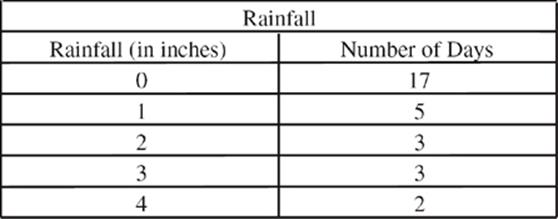
11. What is the mode of the amount of rainfall, in inches, over these 30 days?
(A) 0
(B) 1
(C) 2
(D) 3
(E) 4
12. If 200 inches of rainfall were expected to fall during all of 1998, what percent of the expected yearly rainfall was reached during this 30-day period?
(A) 56%
(B) 42%
(C) 28%
(D) 14%
(E) 7%
13. Line l contains points (3, 2) and (4, 5). If line m is perpendicular to line l, then which of the following could be the equation of line m ?
(A) y = −![]() x + 3
x + 3
(B) y = − ![]() x + 5
x + 5
(C) y = −3x + 5
(D) y = 5x + ![]()
(E) y = 5x + ![]()
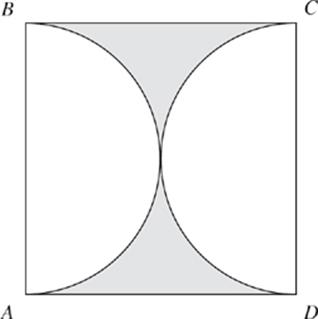
14. In the figure above, ABCD is a square with sides of length 2. The square contains two semicircles with diameters ![]() and
and ![]() . What is the sum of the areas of the two shaded regions?
. What is the sum of the areas of the two shaded regions?
(A) ![]()
(B) 2 – π
(C) 4 – π
(D) 4 – 2π
(E) ![]()
15. Jennifer ran from her house to school at an average speed of 6 miles per hour and returned along the same route at an average speed of 4 miles per hour. If the total time it took her to run to the school and back was one hour, how many minutes did it take her to run from her house to school?
(A) 16
(B) 18
(C) 20
(D) 22
(E) 24
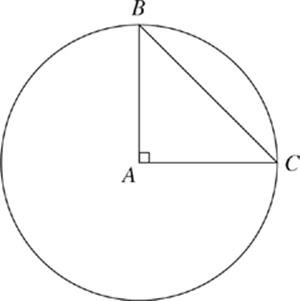
16. In the figure above, ![]() and
and ![]() are radii of the circle with center A. If ΔABC has area 18, what is the circumference of the circle?
are radii of the circle with center A. If ΔABC has area 18, what is the circumference of the circle?
(A) 6π
(B) 9π
(C) 12π
(D) 18π
(E) 36π
17. If a circle has an area that is half its circumference, what is its radius?
(A) ![]()
(B) 1
(C) 4
(D) π
(E) 2π
18. If Marta is assigned to Project A, then the project will be completed on time. Which of the following can be concluded?
(A) If Project A is completed on time, then Marta must have been assigned to Project A.
(B) If Marta was assigned to Project B, then Project A will not be completed on time.
(C) If Project A is not completed late, then no one other than Marta was assigned to Project A.
(D) If Marta is not assigned to Project A, then Project A will be completed late.
(E) If the project is completed one week late, then Marta was not assigned to Project A.
19. The lengths of two sides of a triangle are 5 and 7. If the length of the third side is an integer, what is the least possible perimeter of the triangle?
(A) 12
(B) 13
(C) 14
(D) 15
(E) 17
20. If x2 – x = 12 and y2 – y = 12, what is the greatest possible value of x – y ?
(A) 0
(B) 4
(C) 7
(D) 12
(E) 24
S T O P
If you finish before time is called, you may check your work on this section only.
Do not turn to any other section in the test.
![]()
SECTION 3
Time — 25 minutes
24 Questions
Turn to Section 3 of your answer sheet to answer the questions in this section.
Directions: For each question in this section, select the best answer from among the choices given and fill in the corresponding circle on the answer sheet.
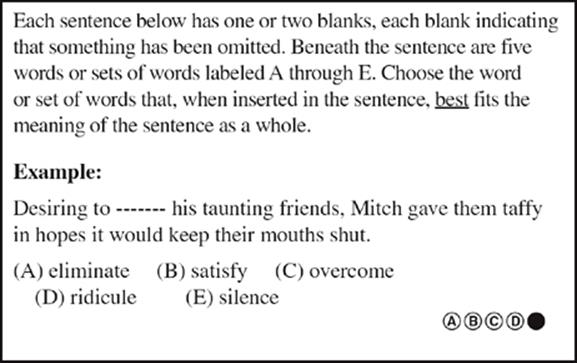
1. While Sarah may have been rather quiet, she was by no means a -------, for she often spent evenings with other people and considered that time to be quite -------.
(A) recluse . . enjoyable
(B) conservative . . worthless
(C) reformer . . irritating
(D) barbarian . . confusing
(E) critic . . demanding
2. One of the serious ------- of meteorology is that natural weather patterns cannot be ------- in the laboratory for investigation.
(A) successes . . achieved
(B) complexities . . broadened
(C) premises . . accredited
(D) limitations . . recreated
(E) advantages . . analyzed
3. The playwright ------- realism and fantasy in her work so well that the audience is never sure whether the characters’ experiences are ------- or imaginary.
(A) integrates . . actual
(B) mingles . . congenial
(C) combines . . apparent
(D) delineates . . indistinct
(E) exposes . . verifiable
4. The improvements made on the new automobile are largely -------; although the exterior has been changed, the engine has remained unchanged.
(A) mechanical
(B) superficial
(C) economical
(D) redundant
(E) expensive
5. Some educators view television as an entirely ------- presence in society, virtually disregarding the idea that television has the potential to be -------.
(A) pernicious . . understood
(B) auxiliary . . discontinued
(C) deleterious . . beneficial
(D) cohesive . . informative
(E) stabilizing . . veiled
6. Zora Neale Hurston’s talent at convincing her readers to believe in the world as she describes it in her novels is due to her ability to create extremely ------- characters.
(A) unsavory
(B) demonstrative
(C) ambiguous
(D) unilateral
(E) credible
7. It is often said that seventeenth-century literature is ------- to today’s readers, especially when compared with more recent works, which introduce fewer problems of -------.
(A) significant . . interpretation
(B) impractical . . tradition
(C) inscrutable . . comprehension
(D) opaque . . contemplation
(E) instructional . . agreement
8. Drew was a ------- boss, one who gave generous holiday bonuses and often overlooked minor lapses in judgment.
(A) miserly
(B) supercilious
(C) disingenuous
(D) munificent
(E) gregarious
Directions: Each passage below is followed by questions based on its content. Answer the questions on the basis of what is stated or implied in each passage and in any introductory material that may be provided.
Questions 9–10 are based on the following passage.
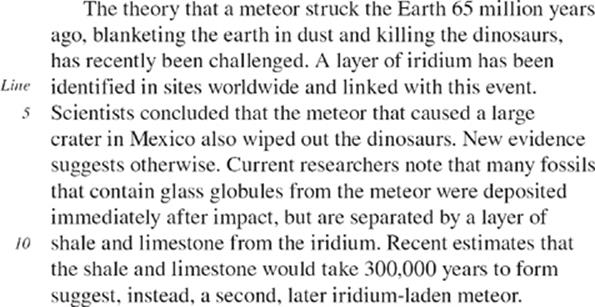
9. The author’s attitude toward the “theory” (line 1) can best be described as
(A) acceptance
(B) outrage
(C) skepticism
(D) amusement
(E) interest
10. The primary purpose of the passage is to
(A) estimate the time when the dinosaurs became extinct
(B) systematically debunk alternatives to the current theory explaining dinosaurs’ extinction
(C) note the contents of meteors, particularly iridium and glass globules
(D) explain conclusively what caused the extinction of the dinosaurs
(E) propose a possible cause of the extinction of the dinosaurs
Questions 11–12 are based on the following passage.
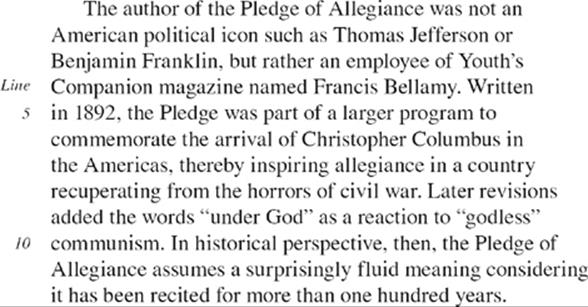
11. The author of the passage mentions Thomas Jefferson and Benjamin Franklin in order to
(A) suggest authors who might have written a better Pledge of Allegiance
(B) emphasize the relative obscurity of the author of the Pledge of Allegiance
(C) provide more information about the origin of the Pledge of Allegiance
(D) commemorate their contributions to American political writings
(E) imply that they inspired Francis Bellamy to write the Pledge of Allegiance
12. It can be most reasonably inferred from the passage that
(A) the Pledge of Allegiance unified Americans after the Civil War
(B) the Pledge of Allegiance has not retained the original phrasing as written by Francis Bellamy
(C) Francis Bellamy would have supported the addition of “under God” to the Pledge of Allegiance
(D) the phrase “under God” sparked great controversy about reciting the Pledge of Allegiance
(E) an earlier version of the Pledge of Allegiance referred to the arrival of Christopher Columbus
Questions 13–24 are based on the following passage.
In this excerpt from a book written in 1984, Dr. Richard M. Restak discusses two different schools of thought in brain research: those who believe there is a strong relationship between the brain and the mind, and those who do not. By citing various neuroscientists, Restak conveys the struggle many scientists have with the issue.
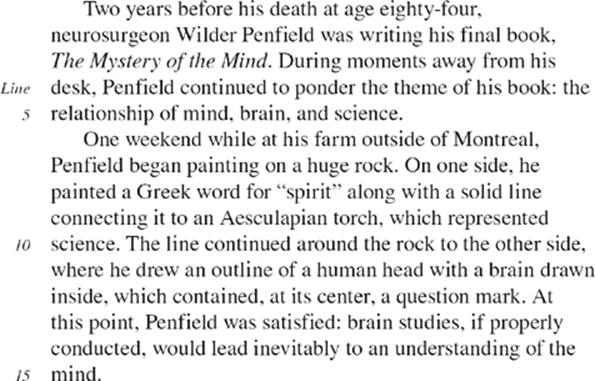
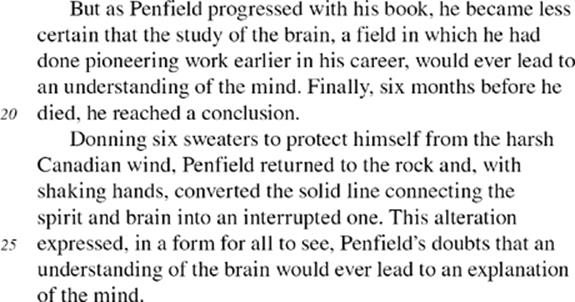
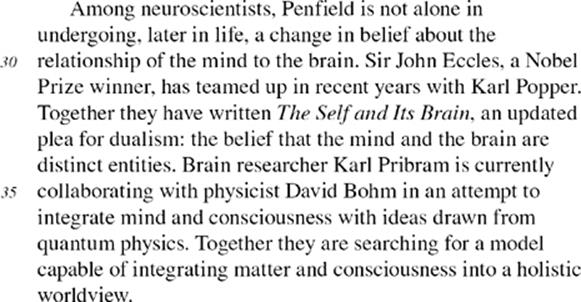
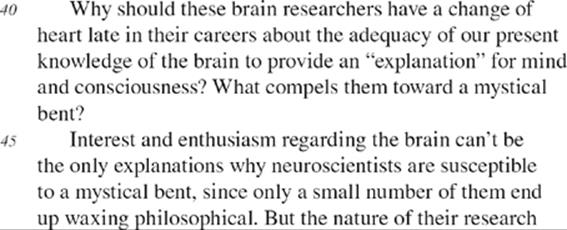
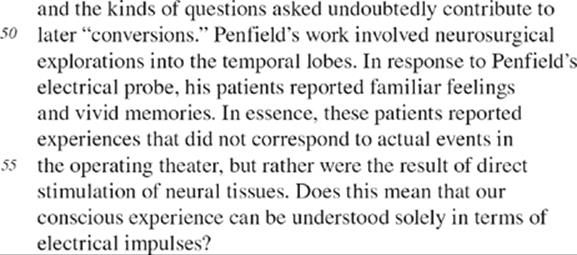
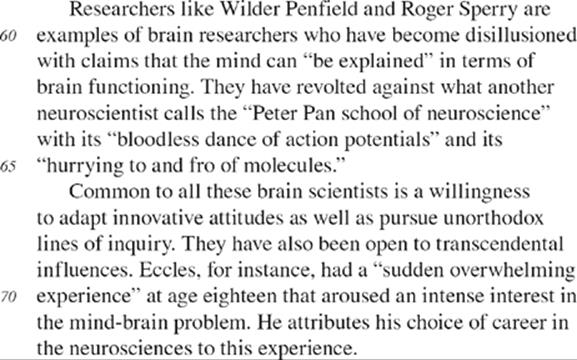
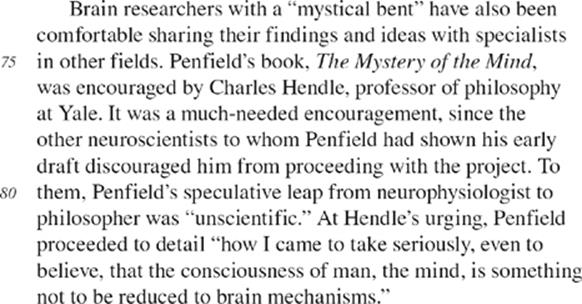
13. The “solid line” painted by Penfield (line 8) represents
(A) Penfield’s desire to link art and science within one discipline
(B) Penfield’s reluctance to make any connections between the mind and the brain
(C) Penfield’s conclusion that experiments had proven the link between the brain and the mind
(D) an example of Penfield’s mental confusion
(E) Penfield’s confidence that the mind would eventually be understood through study of the brain
14. Penfield’s doubts about the validity of the brain-mind connection were tangibly represented by
(A) an Aesculapian torch
(B) a broken line
(C) a Greek word
(D) a large painted rock
(E) a solid line
15. The author mentions Eccles and Popper (lines 30 and 31) in order to
(A) prove that neuroscience is incapable of explaining the mind
(B) give examples of other neuroscientists who altered their convictions about the brain-mind link
(C) indicate that only through teamwork can dualism be fully explained
(D) contrast their beliefs about the relation between the brain and the mind with those of Penfield
(E) present concrete evidence that the brain and the mind are distinct entities
16. It can be inferred from the passage that Pribram and Bohm are investigating whether
(A) a holistic world view could explain quantum physics
(B) consciousness might better be understood through atypical avenues of inquiry
(C) the findings of Eccles and Popper can be proven
(D) new findings in the field of quantum physics show no relationship between matter and consciousness
(E) Penfield’s book contained factual errors that should be corrected
17. The word “bent” in line 44 most nearly means
(A) inclination
(B) distortion
(C) determination
(D) talent
(E) revelation
18. The first sentence of the seventh paragraph (“Interest and … philosophical”) is included in order to
(A) reject a hypothetical response to a question
(B) criticize an opinion expressed earlier in the passage
(C) provide a transition to a new topic
(D) defend a long-held belief that some have questioned
(E) question the value of philosophy in the study of the brain
19. In line 48, “waxing” most nearly means
(A) shining
(B) waning
(C) becoming
(D) increasing
(E) sealing
20. According to lines 50–54, during neurosurgical exploration, Penfield’s patients
(A) behaved like victims of brain traumas
(B) asked their doctor probing questions
(C) followed their impulses while under sedation
(D) perceived events that had never happened
(E) clearly recalled things unrelated to their surroundings
21. It can be inferred that skeptics believe that advocates of the “Peter Pan school of neuroscience” (line 63)
(A) succeed in creating a definitive technique for neurosurgeons to follow
(B) fail to take brain study seriously as a field of endeavor
(C) misunderstand the importance of brain waves in the study of the mind
(D) rely too much on the physiological to explain the workings of the mind
(E) believe that abstract aspects of the mind cannot be explained scientifically
22. The passage suggests that “unorthodox” (line 67) neuroscientists
(A) tend to stay within their own field of study
(B) seek alternative sources for research into the mind
(C) concern themselves primarily with mystical phenomena
(D) regard orthodox scientists with contempt
(E) support exploration that calls on various sources from literature
23. The author mentions Charles Hendle (line 76) in order to
(A) illustrate an expert in a field outside of neuroscience with whom Penfield consulted
(B) establish the superiority of philosophy to neuroscience when studying the mind
(C) criticize Penfield’s lack of confidence in his approach to the brain
(D) highlight an important development in two related fields
(E) introduce an opinion that contradicts the author’s thesis
24. Which of the following statements is NOT supported by the information in the passage?
(A) Speculation about the mind-brain connection extends across disciplines.
(B) Some brain scientists are not unwilling to try avant-garde approaches.
(C) It is not unusual for brain researchers to have a late-in-life change of heart.
(D) Penfield expressed deep doubts about the correctness of his early conclusions.
(E) Properly executed brain studies will eventually lead to a better understanding of the mind.
S T O P
If you finish before time is called, you may check your work on this section only.
Do not turn to any other section in the test.
![]()
SECTION 4
Time — 25 minutes
35 Questions
Turn to Section 4 of your answer sheet to answer the questions in this section.
Directions: For each question in this section, select the best answer from among the choices given and fill in the corresponding circle on the answer sheet.
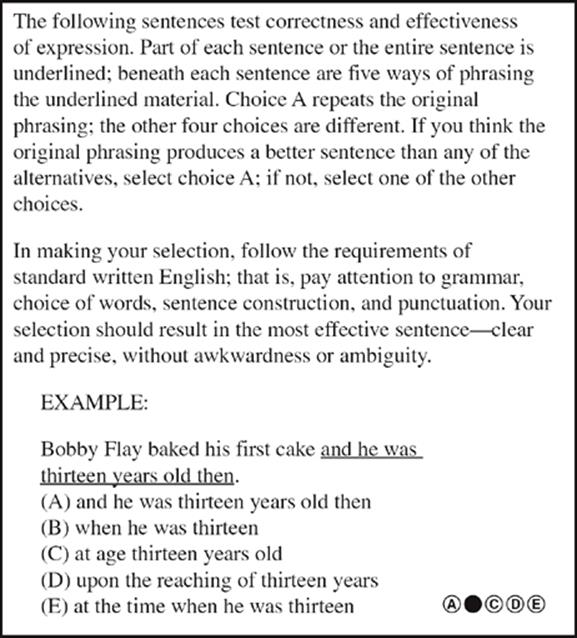
1. Radio broadcasts once were the most popular form of entertainment; families used to gather around the radio at night for their favorite programs.
(A) gather around the radio at night for their favorite programs
(B) gather around to listen to its favorite programs
(C) gather around the radio at night for they’re favorite programs
(D) gather around to listen to it’s favorite programs
(E) gather around the radio at night for there favorite programs
2. Concluding the final session of the communications class, speak slowly and enunciate clearly while making eye contact was the recommendation Ms. Benton gave her students.
(A) speak slowly and enunciate clearly while making eye contact was the recommendation Ms. Benton gave her students
(B) speaking slowly and enunciating clearly while making eye contact were what Ms. Benton told her students to do
(C) her students were advised by Ms. Benton to speak slowly and enunciate clearly while making eye contact
(D) speak slowly and enunciate clearly while making eye contact, recommendations made by Ms. Benton, were what her students should do
(E) Ms. Benton recommended that her students speak slowly and enunciate clearly while making eye contact
3. First president George Washington is credited to breed the first mules in the United States using a jack and a jennet presented to him by the King of Spain in 1786.
(A) to breed
(B) since he bred
(C) by breeding
(D) with breeding
(E) having bred
4. Classical composers who influenced the genre of the string quartet range from Haydn’s credit for its invention in the eighteenth century, as well as Shostakovich.
(A) Haydn’s credit for its invention in the eighteenth century, as well as
(B) Haydn, who in the eighteenth century was inventing it, and
(C) Haydn, who is credited with its invention in the eighteenth century, to
(D) Haydn’s invention in the eighteenth century, for which he received the credit, and
(E) its invention by Haydn, who received the credit in the eighteenth century, to
5. A major cause of stress in school is where seniors must manage not only academic requirements and sports schedules, but also standardized testing and college applications, during the first semester.
(A) where seniors must manage not only academic requirements and sports schedules, but also
(B) seniors need to manage not only academic requirements and sports schedules, but also
(C) where seniors must manage not only academic requirements and sports schedules, and also
(D) when seniors must manage both academic requirements and sports schedules, but also
(E) the management by seniors of not only academic requirements and sports schedules, but also
6. Alaska, the largest state by far with nearly 2.5 times the land area of the next largest state, which has one of the smallest populations with only 650 thousand residents.
(A) state, which has one of the smallest populations
(B) state, that has one of the smallest populations
(C) state and has one of the smallest populations
(D) state, has one of the smallest populations
(E) state, will have one of the smallest populations
7. Stars other than our sun, astronomers have discovered, have planets the size of Jupiter in orbit about them.
(A) astronomers have discovered, have
(B) which, astronomers have discovered, have
(C) having possibly, according to the discovery of many astronomers
(D) there are some astronomers who have discovered that they may have
(E) astronomers are discovering they have
8. She was one of the most famous mystery writers of the century, and Dorothy L. Sayers also built one of her most famous novels around the question of higher education for women in the pre-war era.
(A) She was one of the most famous mystery writers of the century, and Dorothy L. Sayers
(B) One of the most famous mystery writers of the century, Dorothy L. Sayers
(C) Famous mystery writer of the century that she was, Dorothy L. Sayers
(D) Dorothy L. Sayers has been one of the most famous mystery writers of the century, and she
(E) Being one of the most famous mystery writers of the century, Dorothy L. Sayers
9. In addition to having more natural resources, the land area of the United States is significantly larger than most other countries.
(A) the land area of the United States is significantly larger than most other countries
(B) the land area is significantly larger than most other countries for the United States
(C) the United States also has significantly more land area than most other countries
(D) the United states has more land area also than most other significant countries
(E) the land area of other countries is less than that of the United States
10. Carrie, Tanya, and Alex were shopping when, after trying to buy shoes, she realized she didn’t have her wallet.
(A) when, after trying to buy shoes, she realized she didn’t have her wallet
(B) and then she realized she didn’t have her wallet after trying to buy shoes
(C) when Tanya realized she didn’t have her wallet since she tried to buy shoes
(D) and, since Tanya tried to buy shoes, she realized she didn’t have her wallet
(E) when Tanya realized she didn’t have her wallet after trying to buy shoes
11. Clifton Chenier became known as the “King of Zydeco” because of his spending much of his life in the popularizing of zydeco music.
(A) of his spending much of his life in the popularizing of
(B) he spent much of his life popularizing it,
(C) of his popularization for much of his life of
(D) he spent much of his life in the popularizing of
(E) he spent much of his life popularizing

12. 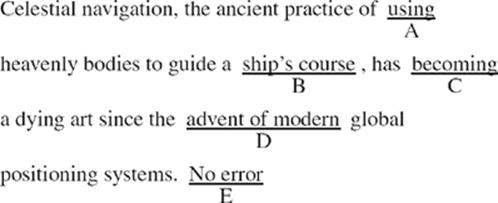
13. 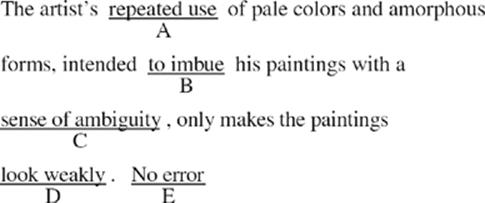
14. 
15. 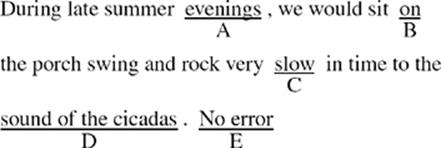
16. 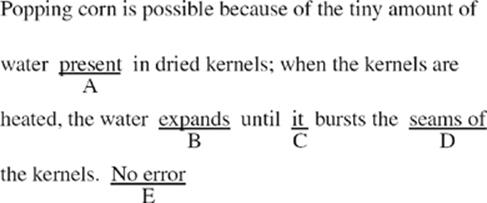
17. 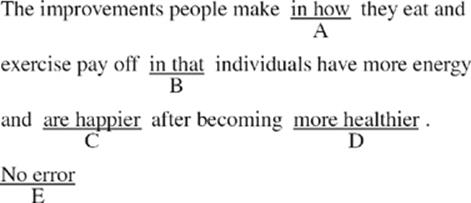
18. 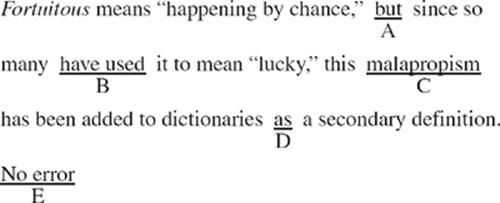
19. 
20. 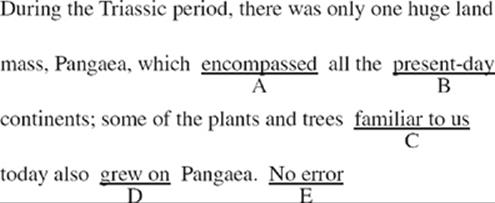
21. 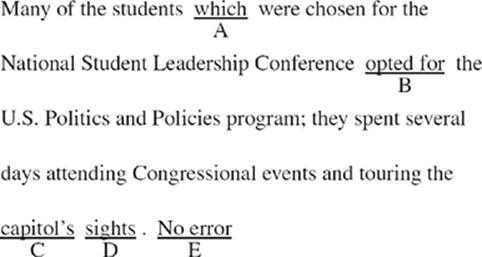
22. 
23. 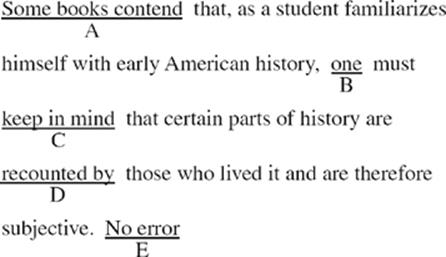
24. 
25. 
26. 
27. 
28. 
29. 
Directions: The following passage is an early draft of an essay. Some parts of the passage need to be rewritten.
Read the passage and select the best answers for the questions that follow. Some questions are about particular sentences or parts of sentences and ask you to improve sentence structure or word choice. Other questions ask you to consider organization and development. In choosing answers, follow the requirements of standard written English.
Questions 30–35 are based on the following passage.
(1) John Graham had been taking pre-law courses at Yale in hopes of becoming a lawyer. (2) In 1980 his career path took a major turn when he decided to be a professional football player. (3) Graham is always enthusiastic about sports, and so his change of path was not a total surprise. (4) When he was growing up in Sayville, New York, he played varsity football in high school.
(5) His father was the Sayville High School football coach. (6) When Graham was playing on the Yale football team, a professional football scout discovered him. (7) Because of this, upon graduating from college, Graham became a part of the New York Jets. (8) After a highly successful football career, he began to receive offers from the major networks for sports commentary jobs. (9) Jobs that relied upon his keen insight and understanding of the workings of football.
(10) Now he is one of the most respected football commentators in the country, frequently compared to Howard Cosell. (11) One might assume that any well-known sports broadcaster would be satisfied enough with his success. (12) A highly compassionate person, Graham cares very much about the assistance he gives to charities that help seriously ill children. (13) Because of the work he has done, he was named “Sportsman of the Year” on two occasions. (14) As an athlete, broadcaster, and philanthropist, John Graham is certainly someone to look up to.
30. In the context of the passage, which of these words would be most logical to insert at the beginning of sentence 2 ?
(A) Certainly,
(B) Of course,
(C) Furthermore,
(D) However,
(E) Predictably,
31. Which of the following changes is most needed in sentence 3 ?
(A) Change “Graham” to “He”
(B) Change “is always” to “had always been”
(C) Omit “and so”
(D) Replace “path” with “paths”
(E) Replace “change of” with “changing”
32. Which of the following is the best revision of the underlined portion of sentence 9 (reproduced below)?
Jobs that relied upon his keen insight and understanding of the workings of football.
(A) These jobs relied
(B) Such jobs were relying
(C) Jobs like these ones relied
(D) In them, he relied
(E) These were relying
33. Which of the following would be the best way to combine sentences 11 and 12 (reproduced below)?
One might assume that any well-known sports broadcaster would be satisfied enough with his success. A highly compassionate person, Graham cares very much about the assistance he gives to charities that help seriously ill children.
(A) Like any well-known sport broadcaster satisfied with his success, Graham is a highly compassionate person, assisting charities that help seriously ill children.
(B) A well-known sports broadcaster, Graham assists charities that help seriously ill children, and is a highly compassionate person.
(C) Graham is a highly compassionate person, which means assisting charities that help seriously ill children as well as being a well-known sports broadcaster.
(D) Graham has shown his compassionate nature, assisting charities which help seriously ill children, and is a well-known sports broadcaster.
(E) Not satisfied with his success as a well-known sports broadcaster, Graham has shown his compassionate nature by assisting charities that help seriously ill children.
34. Which of the following would be the best way to conclude the passage?
(A) (As it is now)
(B) Add the phrase “Of course,” at the beginning of sentence 14.
(C) Omit sentence 14.
(D) Place sentence 13 after sentence 14.
(E) Add the sentence “He too had many accomplishments.” after sentence 14.
35. In context, which of the following is the best sentence to insert between sentences 11 and 12 ?
(A) But not for Graham.
(B) Graham became too well-known for his own good.
(C) For Graham, though, success is not enough.
(D) Graham is a great admirer of Howard Cosell.
(E) Graham, having qualities of success and of caring.
S T O P
If you finish before time is called, you may check your work on this section only.
Do not turn to any other section in the test.
![]()
SECTION 5
Time — 25 minutes
18 Questions
Turn to Section 5 of your answer sheet to answer the questions in this section.
Directions: For this section, solve each problem and decide which is the best of the choices given. Fill in the corresponding circle on the answer sheet. You may use any available space for scratchwork.


1. If x and y are both integers, and xy ≠ 0, which of the following MUST be true of |xy| ?
(A) It is greater than zero.
(B) It is less than zero.
(C) It is an even number.
(D) It is an odd number.
(E) It is a prime number.

2. O is the center of equilateral hexagon ABCDEF, shown above. What is the degree measure of ∠FOD (not shown) ?
(A) 60
(B) 72
(C) 110
(D) 120
(E) 150
3. Which of the following points lies the greatest distance from the origin in the xy coordinate system?
(A) ![]()
(B) (–1, –1)
(C) ![]()
(D) (0, 1)
(E) ![]()
4. If one worker can pack 15 boxes every two minutes, and another can pack 15 boxes every three minutes, how many minutes will it take these two workers, working together, to pack 300 boxes?
(A) 10
(B) 12
(C) 15
(D) 24
(E) 30
5. If the remainder when x is divided by 5 equals the remainder when x is divided by 4, then x could be any of the following EXCEPT
(A) 20
(B) 21
(C) 22
(D) 23
(E) 24
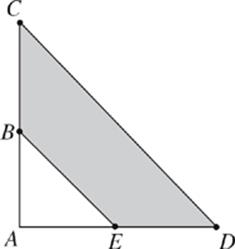
Note: Figure not drawn to scale.
6. If B is the midpoint of ![]() and E is the midpoint of
and E is the midpoint of ![]() , what fraction of ΔACD is shaded?
, what fraction of ΔACD is shaded?
(A) ![]()
(B) ![]()
(C) ![]()
(D) ![]()
(E) ![]()
7. If x > 0 and ![]() , what is the value of x ?
, what is the value of x ?
(A) 4
(B) 3
(C) 2
(D) 1
(E) 0
8. The product of integers x and y is divisible by 36. If x is divisible by 6, which of the following must be true?
I. y is divisible by x.
II. y is divisible by 6.
III. ![]() is divisible by 6.
is divisible by 6.
(A) None
(B) I only
(C) II only
(D) I and III only
(E) II and III only
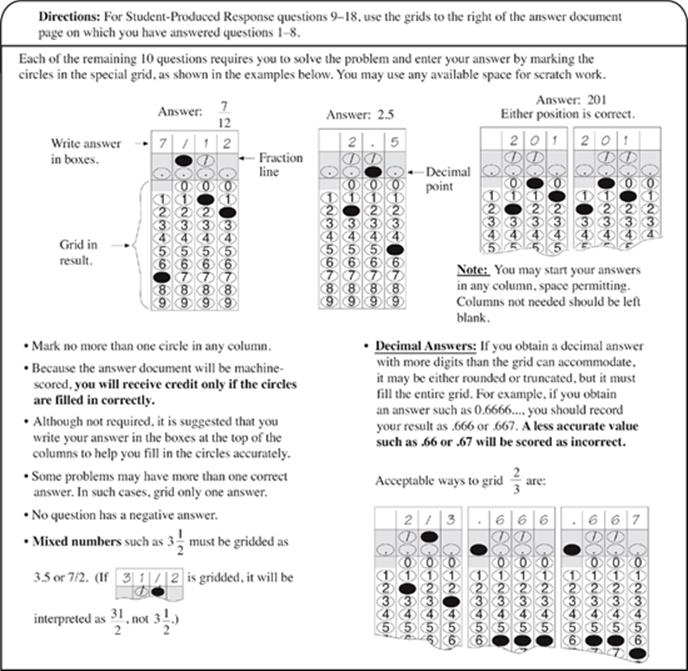
9. If ![]() , then x =
, then x =
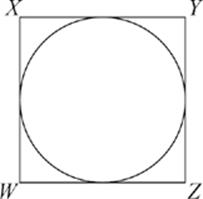
10. In the figure above, a circle is inscribed in square WXYZ. If the area of the circle is 400π, what is the area of WXYZ ?
11. There were 320 students at a school assembly attended only by juniors and seniors. If there were 60 more juniors than seniors and if there were 30 more female juniors than male juniors, how many male juniors were at the assembly?
12. A rectangle of width 5 has a diagonal of length 13. What is the perimeter of the rectangle?
13. Jeannette’s average (arithmetic mean) score for six tests was 92. If the sum of the scores of two of her tests was 188, then what was her average score for the other four tests?
14. If Alexandra pays $56.65 for a table, and this amount includes a tax of 3% on the price of the table, what is the amount, in dollars, that she pays in tax? (Ignore the dollar sign when gridding your answer.)
15. Tiles numbered 1 through 25 are placed in a bag. If one tile is removed at random, what is the probability that the number on the tile is a prime number?
16. Alan and Ben each run at a constant rate of 7.5 miles per hour. Carla runs at a constant rate of 10 miles per hour. Debby runs at a constant rate of 12 miles per hour. In a relay race with these four runners as a team running one right after the other, Alan runs 0.3 miles, then Ben runs 0.3 miles, then Carla runs 0.5 miles, then Debby runs 0.24 miles. What is the team’s average speed in miles per hour?
17. If the distance from (2, 6) to (1, b) is a, ![]() , and b < a, what is the value of b?
, and b < a, what is the value of b?
18. If –1 ≤ a ≤ 2 and –3 ≤ b ≤ 2, what is the greatest possible value of (a + b)(b – a) ?
S T O P
If you finish before time is called, you may check your work on this section only.
Do not turn to any other section in the test.
![]()
SECTION 6
Time — 25 minutes
24 Questions
Turn to Section 6 of your answer sheet to answer the questions in this section.
Directions: For each question in this section, select the best answer from among the choices given and fill in the corresponding circle on the answer sheet.

1. The fireworks display created so much ------- that the night sky was completely -------, almost as if it were the middle of the day.
(A) heat . . exploded
(B) gunpowder . . polluted
(C) color . . decorated
(D) refuse . . detonated
(E) light . . illuminated
2. In speech and in action, she was never haughty or -------; she was always willing to ------- any recommendations, even if she did not agree with them at first.
(A) arrogant . . deny
(B) conceited . . consider
(C) ornery . . oppose
(D) lenient . . embrace
(E) accommodating . . ignore
3. Presidents of large companies have traditionally been very -------; they rarely suggest radical new ideas unless all other options have been investigated and found to be impossible.
(A) inventive
(B) conservative
(C) gentrified
(D) ingenuous
(E) gratuitous
4. Although it has begun to garner -------, until recently, African drum music was virtually ------- by all but those with the most esoteric tastes.
(A) acclaim . . overlooked
(B) respect . . praised
(C) criticism . . ignored
(D) recognition . . played
(E) censure . . disregarded
5. While many health-conscious individuals have stopped eating eggs, dietitians say that in appropriate quantities, eggs can be quite -------.
(A) injurious
(B) erudite
(C) convenient
(D) perfunctory
(E) salubrious
Directions: Each passage below is followed by questions based on its content. Answer the questions on the basis of what is stated or implied in each passage and in any introductory material that may be provided.
Questions 6–9 are based on the following passages.
Passage 1
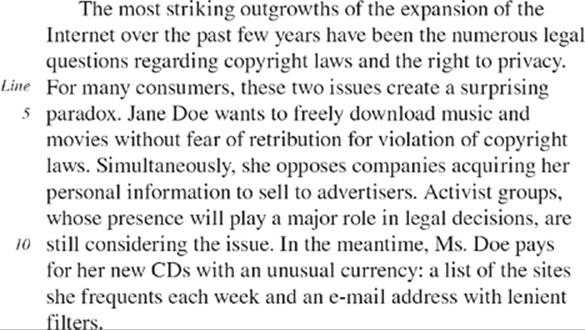
Passage 2
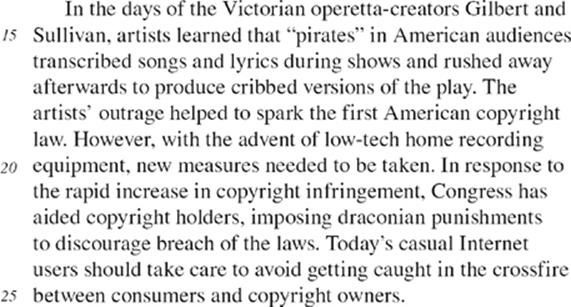
6. The statements about Jane Doe in the third and fourth sentences (lines 5–8)
(A) exacerbate an already controversial issue
(B) argue for more lenient copyright laws
(C) illustrate the contradiction identified in the previous sentence
(D) contradict the paradox explained earlier in the paragraph
(E) apply the theory from the previous sentence to a specific case
7. The content of both passages suggests that Jane Doe and the “pirates” in American audiences hope to
(A) divulge personal details
(B) protect intellectual property
(C) appeal to the activist groups to support their claims
(D) have open access to others’ creative yield
(E) seek retribution for copyright violations
8. It is implied in both passages that
(A) in earlier times, singers and songwriters were glad to share their works freely
(B) existing copyright laws on intellectual property are not always effectual
(C) civic activist organizations deserve more respect than the law
(D) unusual currency is an equitable exchange for intellectual property
(E) artists and songwriters should be more defensive of their property
9. In the context of the passage, the meaning of “draconian” (line 22) is closest to
(A) high-tech
(B) dragon-like
(C) illicit
(D) legal
(E) severe
Questions 10–15 are based on the following passage.
The following passage is about the art and recreation of Southeastern Indians.
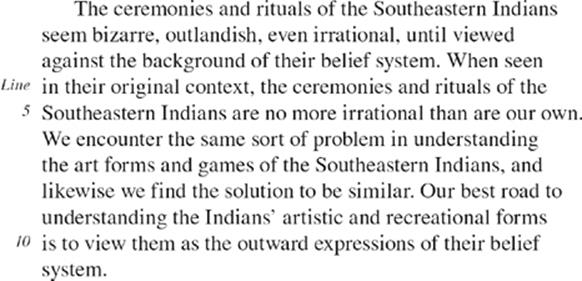
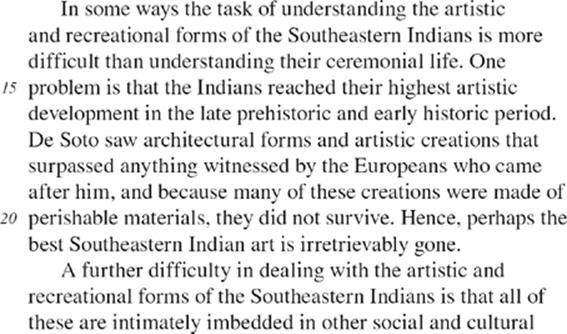
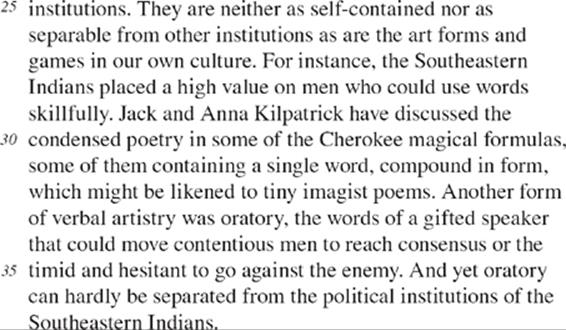
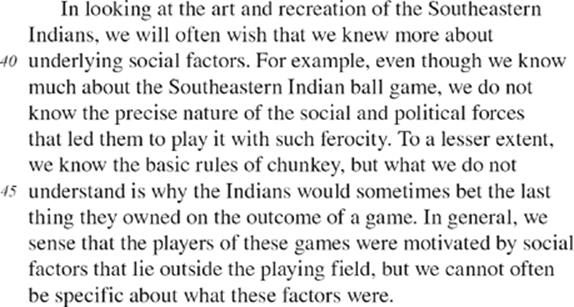
10. The main purpose of the passage is to
(A) show how bizarre certain Southeastern Indian ceremonies and rituals are
(B) explain the rules of several games played by the Southeastern Indians
(C) describe the difficulties inherent in appreciating the Southeastern Indians’ artistic and recreational forms
(D) explore the mysticism of the ceremonies and rituals in the Southeastern Indians’ belief system
(E) delineate the difference between the artistic forms of the Southeastern Indians and the Cherokee Indians
11. Which of the following best describes the “problem” mentioned in line 6?
(A) The belief system of the Southeastern Indians was irrational and therefore impossible to understand.
(B) It is difficult to comprehend the artistic and recreational expression of the Southeastern Indians without understanding their belief system.
(C) A superficial examination of the ceremonies and rituals of the Southeastern Indians makes them appear similar to our own.
(D) Since we have virtually no understanding of the beliefs of the Southeastern Indians, it is unlikely we can understand the significance of their art.
(E) Scholars are unwilling to acquaint themselves sufficiently with the artistic and recreational forms of the Southeastern Indians.
12. The author mentions the loss of many of the Indians’ artistic and architectural creations (lines 19–20) in order to
(A) criticize Indians choice of materials
(B) provide an explanation for a problem
(C) underscore De Soto’s appreciation for Indian creations
(D) delineate an impressive course of events
(E) anticipate a possible objection to a theory
13. It can be inferred from from lines 27–37 (“for instance … Indians”) that
(A) oratory was effective in enhancing one’s athletic ability.
(B) an orator was responsible for composing the magical formulas used in spiritual rituals.
(C) orators were usually the most powerful warriors among the Southeastern Indians.
(D) timid and hesitant speakers could soothe anxious tempers.
(E) a skilled speaker could mend differences between opposing parties.
14. The author mentions the game “chunkey” in line 44 primarily in order to
(A) prove that the Southeastern Indians were more concerned with politics than with organized competition
(B) show how social politics and ferocious violence were interconnected in the lives of the Southeastern Indians
(C) explain how the Southeastern Indians’ interest in competition and artistic endeavor was dictated by separate social factors
(D) provide an example of how the Southeastern Indians’ games may have been motivated by social influences
(E) describe the unusual and ambiguous rules of a little-known competition
15. The author views the current state of understanding about Southeastern Indian games with
(A) irony
(B) pragmatism
(C) wistfulness
(D) appreciation
(E) diffidence
Questions 16–24 are based on the following passage.
The following passage discusses the history and some of the characteristics of jazz.
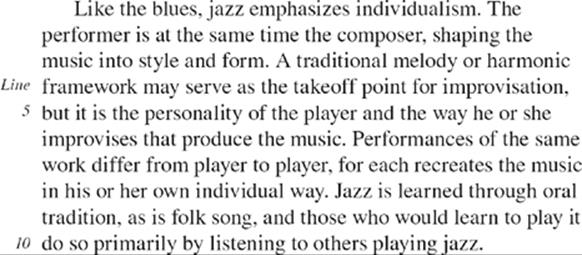
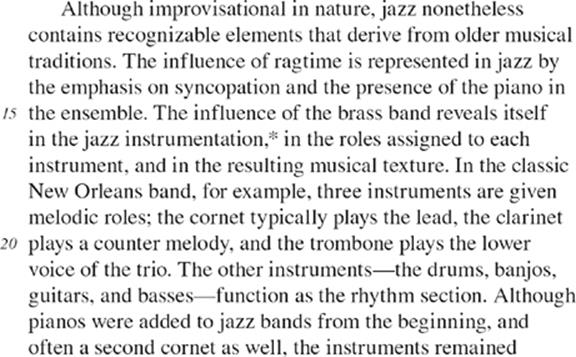
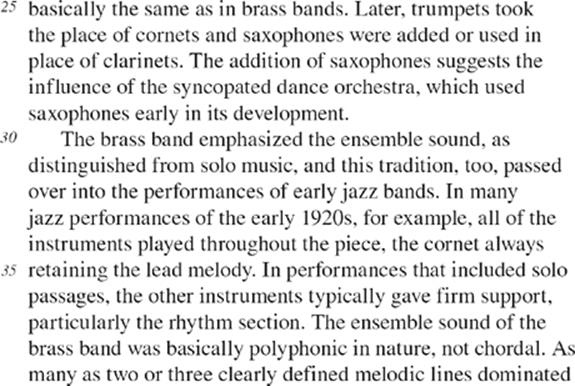
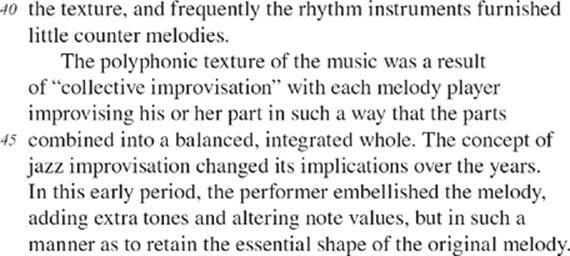

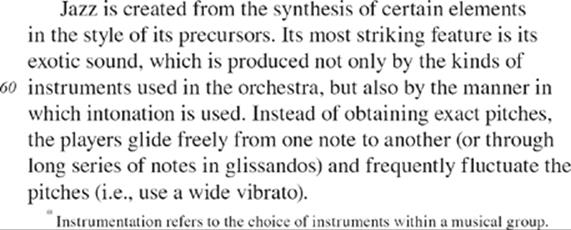
16. The primary purpose of the passage is to show that
(A) three instrument melodies were not the dominant style of jazz
(B) the call-and-response style of the blues was highly successful
(C) blues was a uniquely American form of music with a completely original style
(D) the New Orleans band was the single greatest influence on the evolution of jazz
(E) jazz is a complex musical form that invokes varied traditions
17. It can be inferred from the first paragraph that
(A) blues and jazz existed from a similar source
(B) before jazz, only blues emphasized individualism
(C) the personality of jazz derives from its harmonic framework
(D) the best jazz includes an oral component
(E) a jazz composition may not sound exactly the same from one performance to the next
18. The author uses the examples of “ragtime” (line 13) and “brass bands” (line 15) to illustrate
(A) that jazz is not entirely an original creation
(B) the elements that jazz has passed on to other styles
(C) the origins of certain jazz compositions
(D) the relative growth in popularity of modern jazz
(E) the history that led to the creation of jazz
19. It can be inferred that the use of saxophones in jazz was adopted
(A) because of their superiority to clarinets
(B) to bring syncopation to jazz
(C) by looking to syncopated dance orchestra
(D) to make jazz more popular
(E) after trumpets proved difficult to integrate into jazz
20. The author cites “performances of the early 1920s” (line 33) to suggest that
(A) the cornet is the primary instrument in jazz solos
(B) certain traditions in jazz find their origins in the brass band
(C) the ensemble sound was preferred by audience at the time
(D) the problem of choral music was ultimately sound
(E) jazz is fundamentally an unoriginal music form
21. One of the “salient features” of jazz (line 50) would be that
(A) the instruments mimic human voices
(B) jazz is dominated by singers
(C) music lovers prefer the blues to jazz
(D) the music is composed with singers in mind
(E) every jazz musician is also a jazz singer
22. The word “striking” in line 58 most nearly means
(A) removing
(B) pounding
(C) thoughtful
(D) remarkable
(E) believable
23. The “exotic sound” (line 59) of jazz is primarily a result of
(A) the use of syncopated rhythms
(B) the influences of ragtime and brass bands
(C) the selection of instruments and the ways in which sounds are manipulated
(D) the addition of extra tones and the replacement of one note with another
(E) the first and third beat percussion work
24. According to the passage, the development of jazz was influenced by all of the following EXCEPT
(A) ragtime bands
(B) dance orchestras
(C) brass bands
(D) folk instrumentation
(E) blues singing
S T O P
If you finish before time is called, you may check your work on this section only.
Do not turn to any other section in the test.

SECTION 7
Time — 25 minutes
24 Questions
Turn to Section 7 of your answer sheet to answer the questions in this section.
Directions: For each question in this section, select the best answer from among the choices given and fill in the corresponding circle on the answer sheet.

1. Their daughter’s story that she was robbed of her homework by wandering gypsies was so entirely implausible that the parents believed it to be -------.
(A) an explanation
(B) an intimidation
(C) a fabrication
(D) a rationalization
(E) a confirmation
2. While industry in the late twentieth century believed itself to be ------- in its treatment of laborers, Cesar Chavez made a career of revealing the ------- experienced by farm workers.
(A) generous . . injustices
(B) just . . satisfaction
(C) vindictive . . challenges
(D) superior . . relationships
(E) immutable . . consistency
3. The two teams reached an agreement that was -------: they promised to exchange players of comparable talent.
(A) equitable
(B) variable
(C) hypocritical
(D) inconvenient
(E) extended
4. Professor Yang’s article was unusually -------, but its brevity did not conceal the importance of Yang’s discovery.
(A) intricate
(B) coherent
(C) irrelevant
(D) terse
(E) ambitious
5. The Black Plague was so ------- that in a few short years it had reduced the population of medieval Europe substantially.
(A) lenient
(B) susceptible
(C) suppressed
(D) maudlin
(E) virulent
6. Her promotional tour was ------- by missteps, but the increasing appreciation for her works suggests that the effects of these blunders were -------.
(A) enervated . . destructive
(B) avoided . . ancillary
(C) surrounded . . astute
(D) beleaguered . . negligible
(E) besmirched . . indubitable
7. While the ambassador was not ------- about the path that his country was taking, he did not believe that its economic politics would cause a significant amount of -------.
(A) pragmatic . . affluence
(B) sanguine . . distress
(C) impartial . . ambivalence
(D) despondent . . despair
(E) agitated . . tumult
8. Lisa was known for her ------- speeches in which she rambled for a long time with frequent repetitions about trivial topics.
(A) eloquent
(B) hoarse
(C) garrulous
(D) terse
(E) compelling
Directions: Each passage below is followed by questions based on its content. Answer the questions on the basis of what is stated or implied in each passage and in any introductory material that may be provided.
Questions 9–10 are based on the following passage.
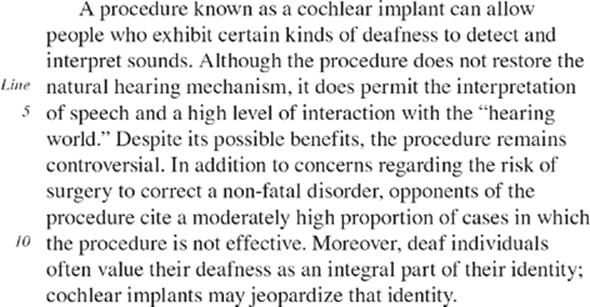
9. The author’s primary purpose is to
(A) argue for the universal implementation of cochlear implants
(B) introduce a procedure and illustrate some of its drawbacks
(C) soundly condemn doctors who perform cochlear implants
(D) admonish those who do not value an individual’s unique identity
(E) describe the scientific basis for a certain type of hearing loss
10. Which of the following most accurately describes the purpose of the final three sentences of the passage?
(A) To illustrate important points about the nature of identity
(B) To discuss possible objections to a potentially beneficial procedure
(C) To offer alternatives to a controversial surgery
(D) To provide factual evidence in support of a disputed theory
(E) To question the appropriateness of surgical interventions in non-fatal maladies
Questions 11–12 are based on the following passage.
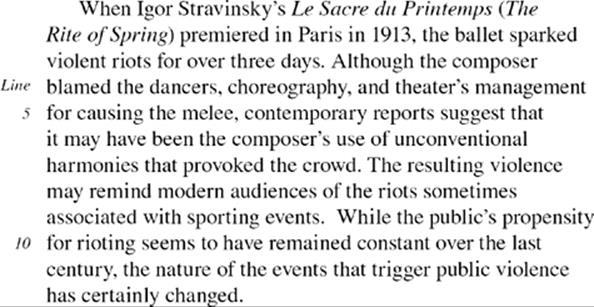
11. Reports at the time suggest that the 1913 riots may have been caused by
(A) theater management
(B) ballet dancers
(C) unconventional harmonies used in the ballet
(D) choreography used in Le Sacre du Printemps
(E) unfavorable reviews
12. Which of the following can be properly inferred from the information above?
(A) Before 1913, people did not riot over public performances.
(B) No prior rioting event had been as long or as widespread as was the 1913 Paris incident.
(C) Stravinsky had hoped to spark violence in support of the arts.
(D) The catalyst of the modern riot may be different from that of its antecedents.
(E) Violence is never justified, regardless of the provocation.
Questions 13–24 are based on the following passage.
The following passage written in 1989 is taken from A Year in Provence by Peter Mayle. This excerpt follows a family’s first exposure to the French district.
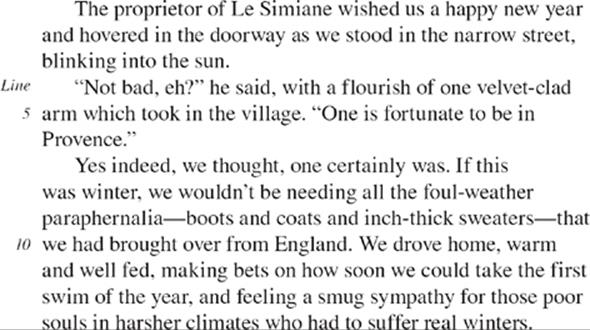
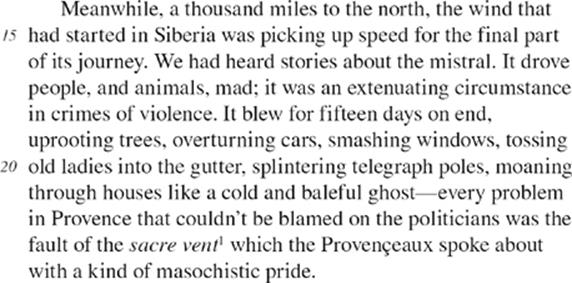
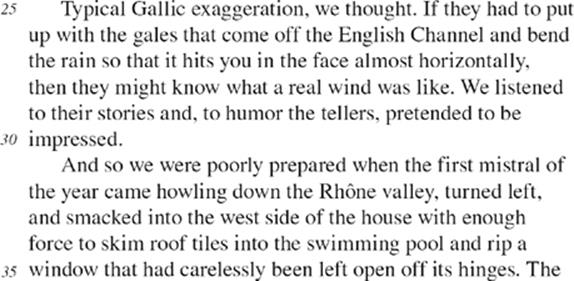
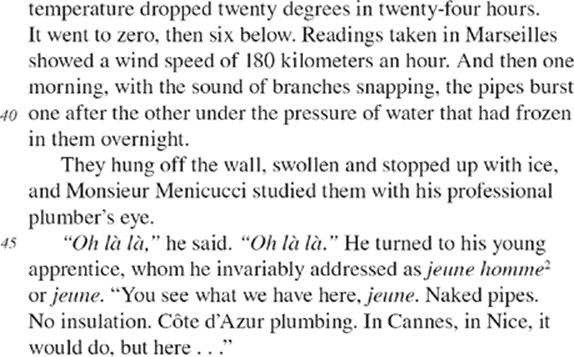
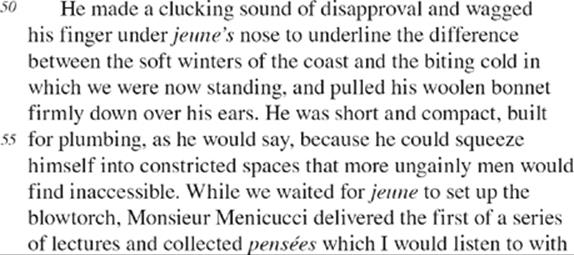
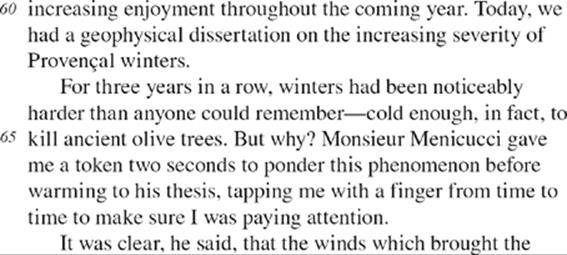
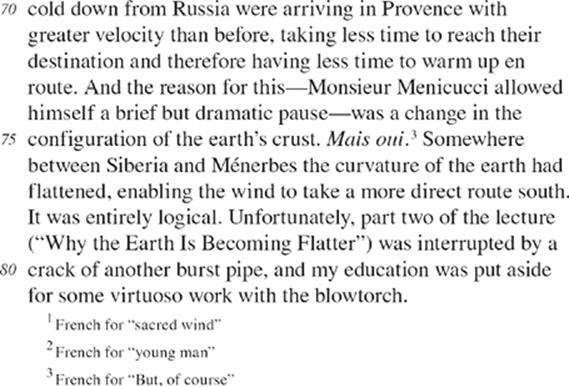
13. The author’s comment about the family “making bets on how soon we could take the first swim of the year” (lines 11–12) refers to
(A) desire to exchange sweaters and boots for swimwear
(B) the longing for real pleasure on an otherwise dull French vacation
(C) the hope that a return to the British shore would cure their homesickness
(D) the faith that the powerful mistral would soon vanish and allow them to swim happily once again
(E) the anticipation of warm weather that would make it conceivable to swim, despite the season
14. The word “poor” in line 12 most nearly means
(A) humble
(B) unfortunate
(C) inferior
(D) destitute
(E) underprivileged
15. It can most reasonably be concluded that the “mistral” (lines 16 and 31) was
(A) the result of weather
(B) caused by politicians
(C) an unwelcome exception to typical conditions
(D) more upsetting to dogs than to humans
(E) a wave of violent crime in Provence
16. The word “baleful” in line 21 most nearly means
(A) lonely
(B) ambitious
(C) sprightly
(D) menacing
(E) rambunctious
17. In line 26 the author implies that “the gales that come off the English Channel”
(A) prevent most nautical vessels from reaching their destination
(B) can combine with a mistral and cause unimaginable havoc across the European countryside
(C) have greater force than their French counterparts
(D) bend the rain into horizontal streams only under certain storm conditions
(E) cause damage only around the English Channel
18. The author’s family was most likely “poorly prepared” for the
(A) rude inhabitants
(B) fierce winds
(C) violent crime
(D) judicial system
(E) unprofessional plumber
19. The “clucking sound of disapproval” (line 50) made by Monsieur Menicucci signifies his
(A) belief that the plumbing installation was inappropriate for the climate conditions
(B) disdain for the English visitors
(C) opinion of his assistant’s work ethic
(D) preference for the warmer winters of the coast
(E) sense that the plumbing in Cannes and Nice is superior to that in Provence
20. The author mentions “ancient olive trees” in order to
(A) emphasize the severity of a recent trend
(B) bemoan the loss of such longstanding landscapes
(C) accuse politicians of making poor choices
(D) remove the link between the mistral and the wave
(E) prove that Provence is ill-suited for olive farming
21. The author implies that Monsieur Menicucci offers the “token two seconds” (line 66)
(A) as an insult to the author whose opinion was not regarded with sufficient consideration
(B) in sincere hope that the author might be able to shed some light on the mystery
(C) as a courtesy, since Menicucci believes he can provide an answer on the phenomenon’s cause
(D) in confusion, momentarily forgetting what he had been discussing
(E) to reveal his own respect for the weather’s capacity for destruction
22. In line 75, the author’s comment “Mais oui” suggests the author regards Menicucci as a
(A) highly educated thinker whose theory is provocative
(B) confused character who cannot adequately articulate his ideas
(C) plumber whose grasp of the English language is impressive
(D) slightly pompous comic figure who perceives himself as quite knowledgeable
(E) deceitful man interested in misleading the author into believing fanciful tales
23. Which of the following best describes Menicucci’s theory about the earth’s crust?
(A) The burst pipes were the result of the increased velocity of the mistral.
(B) Siberia is gradually moving closer to Provence.
(C) The presence of wind in most regions is completely determined by the curvature of the earth.
(D) Wind slows down across a flat plain, since it wants to change directions.
(E) A deviation in the earth’s shape results in changes in weather patterns.
24. The author’s use of the word “unfortunately” (line 78) is best described as
(A) distressed
(B) unconventional
(C) sardonic
(D) estranged
(E) candid
S T O P
If you finish before time is called, you may check your work on this section only.
Do not turn to any other section in the test.
![]()
SECTION 8
Time — 20 minutes
19 Questions
Turn to Section 8 of your answer sheet to answer the questions in this section.
Directions: For each question in this section, select the best answer from among the choices given and fill in the corresponding circle on the answer sheet.

1. Upon learning that she had won the grand prize instead of just any prize, her initial joy turned into -------.
(A) apathy
(B) euphoria
(C) spontaneity
(D) contention
(E) misery
2. The increased humidity coupled with oppressively high temperatures made us feel ------- at the beach this summer.
(A) earnest
(B) animated
(C) resilient
(D) exotic
(E) listless
3. Anthropologists had long assumed that hunter-gatherers moved continually in their search for food; however, recent findings indicate that during the Mesolithic period, such groups were often quite -------.
(A) prudent
(B) credulous
(C) industrious
(D) indigent
(E) sedentary
4. Since none of the original doors or windows of the Mayan Indian homes have survived, restoration work on these portions of the buildings has been largely -------.
(A) exquisite
(B) impertinent
(C) speculative
(D) decorous
(E) abstract
5. The council was divided into such strong factions that it was almost impossible to garner ------- support to pass the bill.
(A) biased
(B) strenuous
(C) bureaucratic
(D) bipartisan
(E) unnecessary
6. The boys expected to be admonished for their -------, so it was no surprise when they were severely ------- by their parents.
(A) proficiency . . censured
(B) magnanimity . . beguiled
(C) dilemma . . esteemed
(D) roguery . . nonplussed
(E) impishness . . castigated
Directions: Each passage below is followed by questions based on its content. Answer the questions on the basis of what is stated or implied in each passage and in any introductory material that may be provided.
Questions 7–19 are based on the following passages.
The following passages deal with the question of air pollution. Passage 1 gives a broad historical overview, and Passage 2 discusses one type of pollutant.
Passage 1
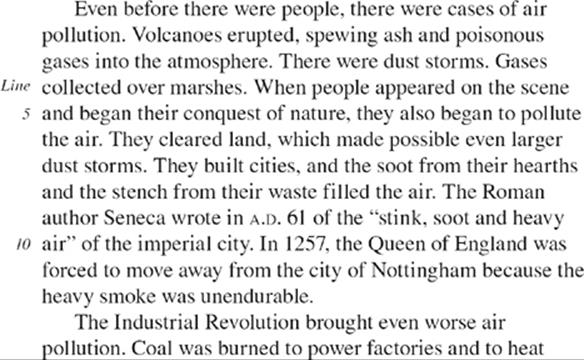
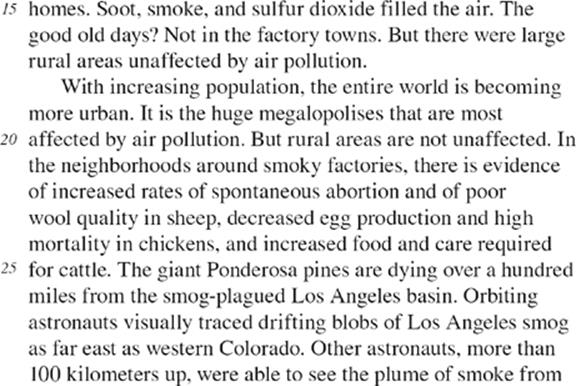
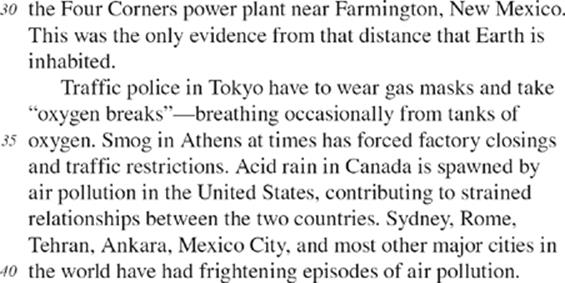
Passage 2
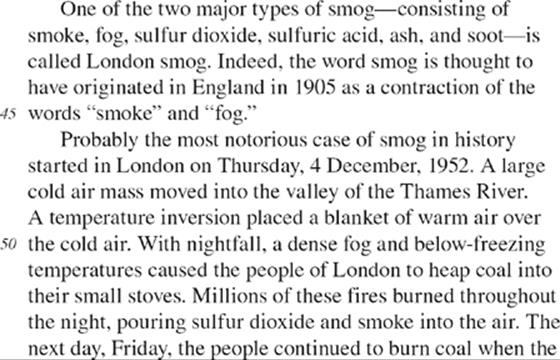
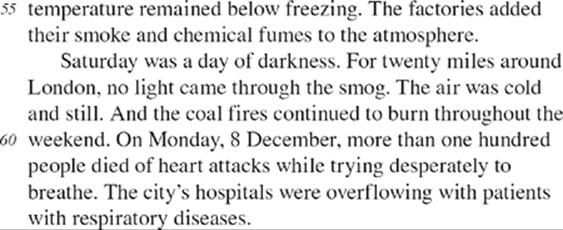
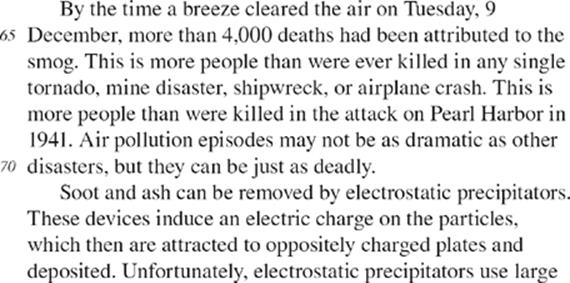
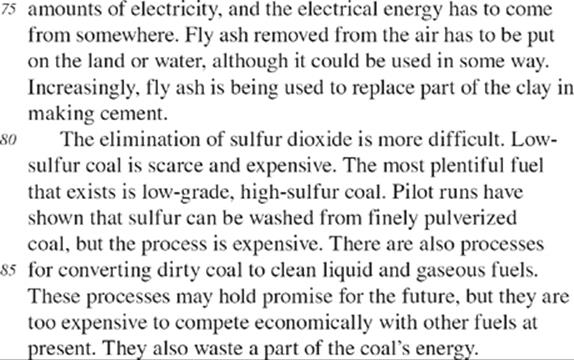
7. Which factor mentioned in Passage 1 most likely contributed to the environmental disaster described in Passage 2?
(A) The Industrial Revolution
(B) Natural sources of air pollution
(C) Land clearing
(D) Heavy smoke from Nottingham
(E) Improper disposal of solid waste
8. Passage 1 implies that air pollution
(A) was originally caused by the Industrial Revolution
(B) affects only urban areas
(C) has natural as well as manmade causes
(D) will never be eliminated through the use of better fuels because they are too expensive
(E) seriously affects the nervous systems of both people and animals
9. The author of Passage 1 uses both the Roman author Seneca and the Queen of England (lines 9–12) as evidence that
(A) civilization has necessarily caused air pollution
(B) air pollution has always existed in cities
(C) urban air pollution is not just a modern problem
(D) humanity disregards its environment
(E) recently, the level of air pollution has risen dramatically
10. According to the author of Passage 1, air pollution problems of today differ from those of the “Industrial Revolution” (line 13) and before in that
(A) remote communities may now feel the effects of air pollution regardless of their proximity to the source of the pollution
(B) today’s polluted factory towns were once clean rural communities unaffected by urban air pollution
(C) modern urban areas are no longer more polluted than the suburban and rural communities that surround them
(D) the use of coal as fuel has greatly increased the number of cities and megalopolises that are contributing to the world’s air pollutants
(E) modern disasters caused by incidents of extreme air pollution cause far more damage than they did hundreds of years ago
11. The orbiting astronauts are discussed by the author (lines 26–32) in order to
(A) demonstrate the increased urbanization of modern civilization
(B) prove that air pollution is an inevitable consequence of human progress
(C) support the claim that pollution has become the defining characteristic of modern society
(D) provide evidence that pollution is no longer restricted to urban areas
(E) further the argument that large urban areas are most affected by air pollution
12. The last paragraph of Passage 1 suggests that air pollution causes all of the following EXCEPT
(A) difficulties in international relations
(B) otherwise unnecessary closings of businesses
(C) changes in the quality of some water
(D) changes in work habits
(E) high levels of lung disease
13. The author of Passage 2 discusses the 1952 outbreak of London smog (line 46–47) in order to
(A) demonstrate that smog has serious effects that are not controllable by human action
(B) point out that air pollution is a major threat to human health only over a long period of time
(C) describe a notable example of a type of air pollution
(D) support the claim that air pollution must be controlled
(E) prove that the toxic effects of air pollution are far worse in Europe than in the United States
14. According to Passage 2, London smog can best be described as
(A) a deadly type of air pollution that cannot be completely eliminated
(B) a phenomenon responsible for more deaths than from any other natural cause
(C) a threat to human health that we are often unaware of
(D) a combination of fog conditions and heavy accumulations of smoke from fossil fuel fires
(E) a new, mostly uninvestigated, type of air pollution
15. The statistics cited in lines 64–70 imply that
(A) any effects of a serious air pollution episode cannot be seen until some time after the episode
(B) air pollution typically produces more traumatic health problems than do other disasters
(C) most of the fatalities from air pollution do not occur during an air pollution episode
(D) air pollution episodes can be among the most devastating types of disasters
(E) it is impossible to know the total death rate from a given episode of air pollution
16. Passage 2 suggests that “electrostatic precipitators” (line 71) work by a process which
(A) provides a perfect solution to a particular problem
(B) eliminates sulfur dioxide as quickly as soot and ash
(C) requires more electricity than can be generated at one time
(D) may cause more problems than they solve
(E) will eventually be used to make clay pottery
17. The author of Passage 2 believes that the removal of sulfur dioxide from air pollution is difficult because
(A) the technology to remove sulfur dioxide is only currently in development
(B) any successful process utilizes more natural resources than it produces
(C) sulfur is made up of very resilient molecules that cannot be broken down easily
(D) sulfur is a basic compound in all fuels that are currently used
(E) the available methods are costly and involve some waste
18. It can be inferred that the author of Passage 1 would agree with which statement about the cost of pollution control discussed in Passage 2?
(A) Society must be prepared to spend whatever it takes to eliminate all forms of air pollution.
(B) The cost of pollution control is too high to make it economically efficient with current technology.
(C) The more we are concerned with limiting the effects of pollution, the less we will be able to eliminate the sources of pollution.
(D) Dealing with pollution can be a significant challenge for urban populations.
(E) The cost of pollution control is much higher than the cost of changing to better energy sources.
19. Which of the following is a difference between the two passages?
(A) Passage 1 views air pollution as a timeworn problem, while Passage 2 focuses only on the modern era.
(B) Passage 1 discusses the effect air pollution has had on both urban and rural areas, while Passage 2 focuses only on rural areas.
(C) Passage 1 uses several historical examples to illustrate the dangers of air pollution, while Passage 2 relies on academic research.
(D) Passage 1 recognizes the Industrial Revolution as a major factor in air pollution, while Passage 2 contends that it was no worse than other factors.
(E) Passage 1 provides a number of details on the effect of air pollution, while Passage 2 provides both details and an examination of possible solutions to the problem of air pollution.
S T O P
If you finish before time is called, you may check your work on this section only.
Do not turn to any other section in the test.

SECTION 9
Time — 20 minutes
16 Questions
Turn to Section 9 of your answer sheet to answer the questions in this section.
Directions: For this section, solve each problem and decide which is the best of the choices given. Fill in the corresponding circle on the answer sheet. You may use any available space for scratchwork.


1. Which of the following represents the statement “the sum of the squares of x and y is equal to the square root of the difference of x and y”?
(A) ![]()
(B) ![]()
(C) ![]()
(D) ![]()
(E) ![]()
2. If 3a + 2b + c = 22, b + c = 8, and c = 6, what is the value of a + b + c?
(A) 4
(B) 8
(C) 12
(D) 18
(E) 36
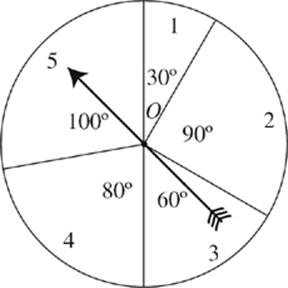
3. In the ABC board game, the circular spinner centered at O shown in the figure above is used to determine how far a player’s piece will advance on the board during a given turn. After each spin, the arrow points in a random direction, and the number printed in the region where the arrow points gives the number of spaces a piece will advance. What is the probability that Kim’s piece will advance 3 or 4 spaces during her turn?
(A) ![]()
(B) ![]()
(C) ![]()
(D) ![]()
(E) ![]()
4. If x and y are integers such that 4x – 8 > 0 and 4y + 8 < 0, then which of the following must be true?
(A) xy is even.
(B) xy is odd.
(C) xy is negative.
(D) xy is positive.
(E) xy is equal to zero.
5. A rectangle with length 16 and width 6 has an area that is 3 times the area of a triangle with height 8. What is the length of the base of the triangle?
(A) 4
(B) 8
(C) 12
(D) 16
(E) 22
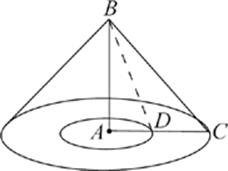
Note: Figure not drawn to scale.
6. A right circular cone is drawn above, with two circles centered at A on its base as shown. AB is the height of the cone, the measure of ∠ABC is 60°, and ![]() has a length of y. If
has a length of y. If ![]() bisects ∠ABC, which of the following gives the area of the smaller circle in terms of y ?
bisects ∠ABC, which of the following gives the area of the smaller circle in terms of y ?
(A) 8π![]()
(B) 4π![]()
(C) yπ
(D) ![]()
(E) ![]()
7. During the past week, a factory produced 10,000 computer disks, of which 30 were found to be defective. At this rate, if the factory produced 1,000,000 computer disks, approximately how many would be defective?
(A) 3
(B) 30
(C) 300
(D) 3,000
(E) 30,000
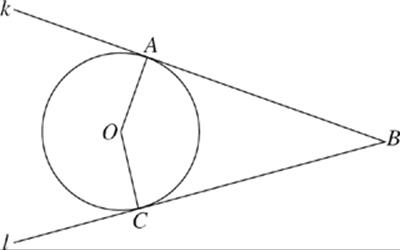
Note: Figure not drawn to scale.
8. In the figure above, lines k and l are tangent to the circle with center O at points A and C, respectively. If OB = 4, OA = AB, AB = BC, and ![]() ⊥
⊥ ![]() then OA =
then OA =
(A) ![]()
(B) 2
(C) 2![]()
(D) 4
(E) 4![]()
9. If it costs z dollars to buy n pizzas, how much will it cost, in dollars, to buy b pizzas at the same rate?
(A) ![]()
(B) ![]()
(C) ![]()
(D) ![]()
(E) znb
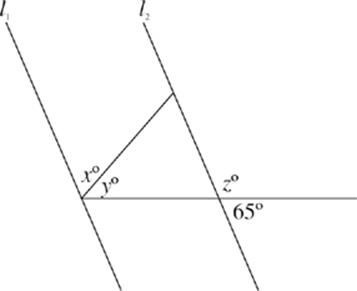
10. In the figure above, if l1 || l2 and x = 55, then y + z =
(A) 120
(B) 145
(C) 175
(D) 180
(E) 195
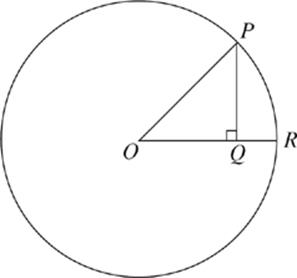
Note: Figure not drawn to scale.
11. In the circle above with center O, OQ = QR. If the radius of the circle is 8, what is the area of ΔOPQ ?
(A) 4
(B) 4![]()
(C) 8
(D) 8![]()
(E) 16
12. Eighty students went on a class trip. If there were 14 more boys than girls on the trip, how many girls were on the trip?
(A) 26
(B) 33
(C) 40
(D) 47
(E) 66
13. For all x, let f(x) = (10 – x)2. If p = f(6), which of the following is equal to 4p ?
(A) f(24)
(B) f(18)
(C) f(12)
(D) f(8)
(E) f(4)
14. If b is a positive number not equal to 1, which of the following must also be positive?
(A) ![]()
(B) ![]()
(C) ![]()
(D) 2 – b
(E) 2b – 1
15. What is the distance between the x-intercept and the y-intercept of the line y = ![]() x − 6?
x − 6?
(A) 9
(B) 15
(C) ![]() (approximately 9.43)
(approximately 9.43)
(D) ![]() (approximately 10.82)
(approximately 10.82)
(E) 15 + ![]() (approximately 25.82)
(approximately 25.82)
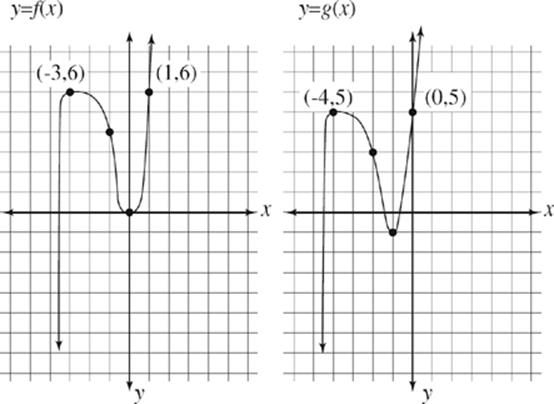
16. The figures above show the graphs of the functions f and g. The function f is defined by f(x)= 2x3 + 5x2 – x. The function g is defined by g(x) = f(x – h) – k, where h and k are constants. What is the value of hk ?
(A) –2
(B) –1
(C) 0
(D) 1
(E) 2
S T O P
If you finish before time is called, you may check your work on this section only.
Do not turn to any other section in the test.
![]()
SECTION 10
Time — 10 minutes
14 Questions
Turn to Section 10 of your answer sheet to answer the questions in this section.
Directions: For each question in this section, select the best answer from among the choices given and fill in the corresponding circle on the answer sheet.
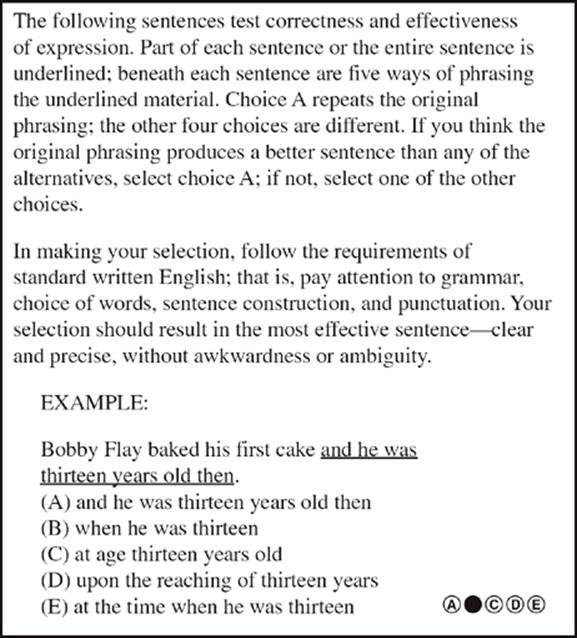
1. Theater doesn’t allow much extra time, a fact with which Ryan is familiar being as he was in many different productions.
(A) being as he was
(B) as he has been
(C) seeing as how he will be
(D) being that he was
(E) because he will be
2. In order to follow the building code for commercial construction, all doors should be at least 3 feet wide and swing outward to allow wheelchair access.
(A) at least 3 feet wide and swing outward to allow wheelchair access
(B) at least 3 feet wide and swung outward to allow wheelchair access
(C) at least 3 feet wide and should be made to swing outward to allow wheelchair access
(D) at least 3 feet wide or wider and swing outward to allow wheelchair access
(E) at least 3 feet wide or wider and swung outward to allow wheelchair access
3. On a Sunday Afternoon on the Island of the Grande Jatte, a nineteenth-century pointillism masterpiece by Seurat, is one of the better examples of paintings created in this unique style.
(A) a nineteenth-century pointillism masterpiece by Seurat, is one of the better examples
(B) Seurat’s pointillism masterpiece of the nineteenth-century can be one of the best examples
(C) a nineteenth-century pointillism masterpiece by Seurat, is to be one of the better examples
(D) Seurat’s pointillism masterpiece, is one of the best examples in the nineteenth century
(E) a nineteenth-century pointillism masterpiece by Seurat, is one of the best examples
4. American etiquette is different from other countries in that it requires the recipients of compliments to accept them with thanks, rather than turn them aside with protest.
(A) other countries
(B) other countries are
(C) that of another country
(D) what another country is
(E) that of other countries
5. Dr. Eglise’s students were required to do a certain amount of preparation for each class: this being that they had to read an article he gave them and brainstorm ideas for an essay on the same topic.
(A) class: this being that they had to
(B) class, including
(C) class: they had to
(D) class, however having to
(E) class, and they had to not only
6. Renowned for her writing across several subjects and genres, Barbara Kingsolver’s poems are impassioned denunciations of violence in Central America.
(A) genres, Barbara Kingsolver’s poems are impassioned denunciations of
(B) genres; Barbara Kingsolver wrote poems that are impassioned denunciations of
(C) genres, Barbara Kingsolver writes poems which passionately denounce
(D) genres, the poems of Barbara Kingsolver poems passionately denounce
(E) genres; passionately denouncing is what Barbara Kingsolver’s poems do to
7. The scientist allowed very few of his experiments to be published because his exacting standards caused him to question whether his findings were complete and able to be shown to the scientific community.
(A) because his exacting standards caused him to question
(B) as a result of his standards being exacting, he questioned
(C) having exacting standards causing him to question
(D) his standards being so exacting that he questioned
(E) because of his exacting standards, which causing him to question
8. Although the badger has a reputation as a fierce animal, it has a gentler side which is shown in several works of literature, these include Cold Moons by Aeron Clement and Incident at Hawk’s Hill by Allen Eckert.
(A) literature, these include
(B) literature, two of these are
(C) literature, these being
(D) literature, such as
(E) literature, like
9. A majority of the girls in Toria’s class wore sandals even on wintry days, however there was a great effort made by teachers and parents to discourage them from doing so.
(A) however there was a great effort made by teachers and parents
(B) along with great efforts made by the teachers and parents
(C) when even parents and teachers are making the effort
(D) despite great efforts made by teachers and parents
(E) even though great efforts by teachers and parents
10. After polling the parish, the church’s roof committee voted to replace the slate tiles with asphalt shingles and they did this to save thousands of dollars.
(A) and they did this to
(B) and so it could
(C) they wanted to
(D) in order that they might
(E) in order to
11. A truck collided with Emma’s car and, although she was uninjured, she could hardly stop trembling with fright.
(A) uninjured, she could hardly stop
(B) uninjured; she couldn’t hardly stop
(C) uninjured, she couldn’t hardly stop
(D) uninjured, since she couldn’t stop
(E) uninjured, she could, however, hardly stop
12. Because of the danger of rabies within the state, this is the reason for the ban on transporting skunks and raccoons to open spaces across town lines.
(A) this is the reason for the ban on transporting skunks and raccoons to open spaces across town lines
(B) there is a ban on transporting skunks and raccoons to open spaces across town lines
(C) a ban on skunks and raccoons in open spaces across town lines has been declared
(D) a ban has been declared on skunks and raccoons openly across town lines
(E) it is the reason for the open ban to transport skunks and raccoons to spaces across town lines
13. The population of Las Vegas, the fastest growing city in the United States, has increased by more than three times in the past hundred years.
(A) has increased by more than three times
(B) increased by more than three times
(C) was more than tripled
(D) has more than tripled
(E) had more than tripled
14. Several recent studies have indicated that a student’s ability to seek help from their teachers predicts college success as well as a standardized test score does.
(A) to seek help from their teachers predicts
(B) in seeking help from their teachers and predicting
(C) to seek help from teachers predicts
(D) to seek help from his or her teachers always predicts
(E) to not only seek the help of teachers but also predict
S T O P
If you finish before time is called, you may check your work on this section only.
Do not turn to any other section in the test.
PRACTICE TEST 3: ANSWER KEY
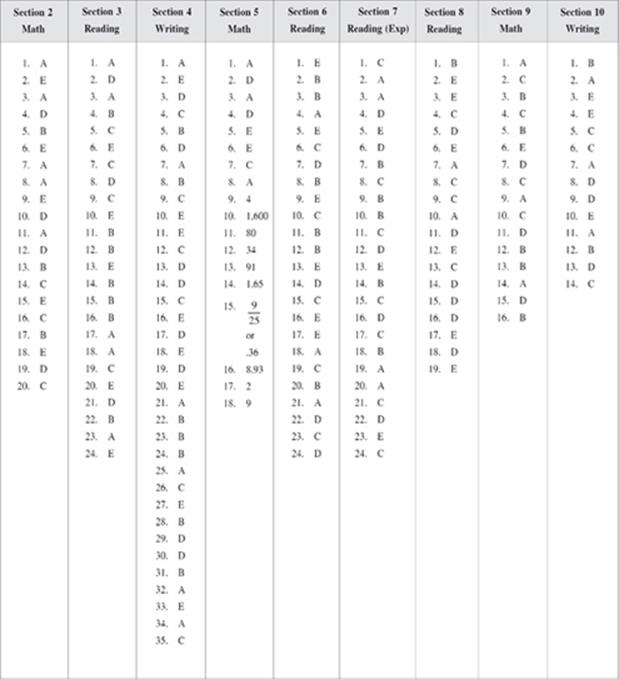
SAT SCORING WORKSHEET
For directions on how to score your SAT practice test, see this page. Section 7 is the unscored, Experimental section.
(Click here to download a PDF of the Scoring Worksheet)
SAT Writing Section
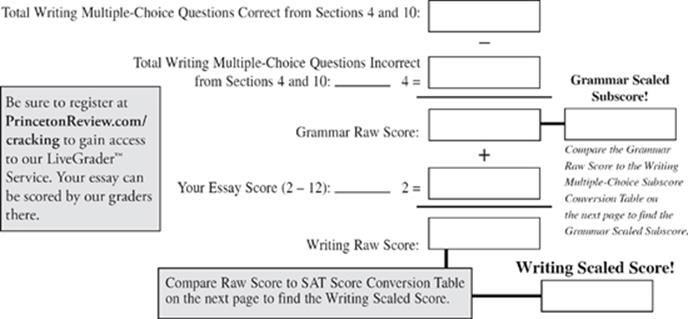
SAT Critical Reading Section

SAT Math Section
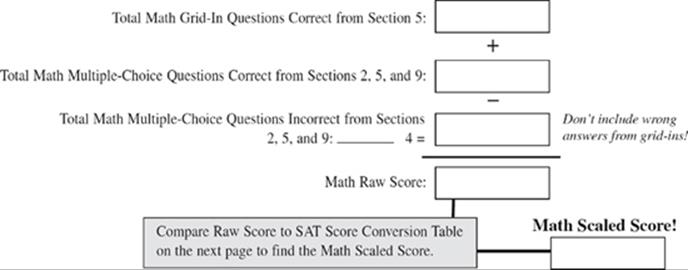
SAT SCORE CONVERSION TABLE
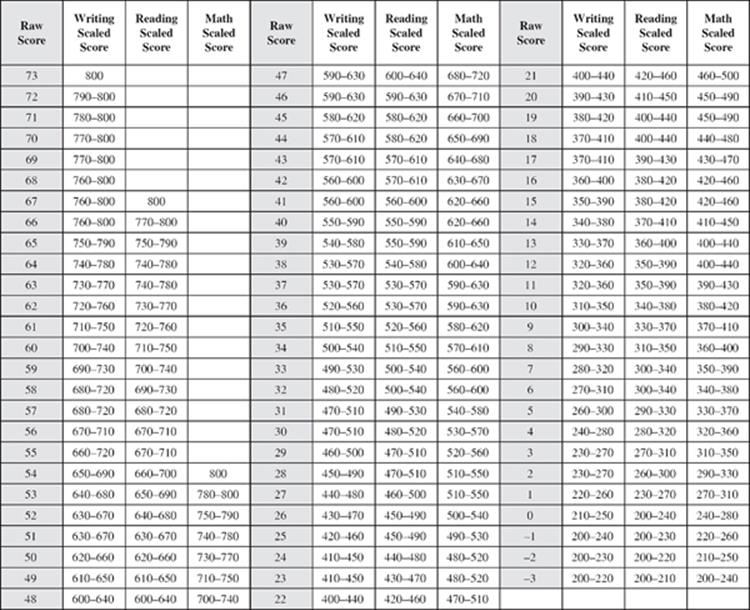
WRITING MULTIPLE-CHOICE SUBSCORE CONVERSION TABLE
